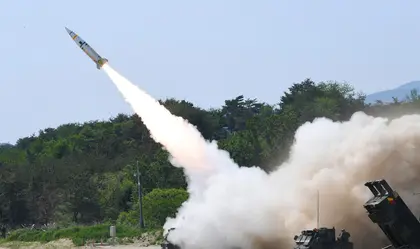Hopes are rising in Kyiv that the US could be on the verge of announcing it will send the long-requested ATACMS missile system to Ukraine.
According to a report in the Financial Times on Sunday, President Biden is close to making a final decision on sending the weapons to Kyiv to bolster its counteroffensive against Russian forces.
“A decision could be coming soon,” a senior Biden administration official told the newspaper.
The FT also said Andriy Yermak, chief of staff to President Zelenskyy, was confident the US would agree to send ATACMS, saying: “Yes, we are talking about it . . . In every conversation with [US national security adviser] Jake Sullivan this question arises.
“They understand [ATACMS] are very much needed. I believe it will be agreed and very, very soon.”
If confirmed, it would mark yet another about turn in US policy on which weapons to provide to Ukraine.
In February both official and unofficial US statements said unequivocally that they would not be providing ATACMS. It was assumed this was because of fears that Ukraine could use the enhanced capability to attack targets on Russian territory.
Many commentators and the Ukrainian government hoped that the US position would change, as it had done for by other US weapons systems that were first denied but ultimately approved such as the F-16 fighter jet.
Why Ukraine wants them
“Ukraine needs long-range missiles,” President Zelensky said in a January video address, “to deprive the occupier of the opportunity to place its missile launchers somewhere far from the front line and destroy Ukrainian cities.”

N. Korean Troops Massed in Russia to Enter Ukraine War ’Soon’: Pentagon Chief
The President and other Ukrainian government representatives have taken every opportunity since then to press the case. They believe that the 300-kilometer range of the ATACMS is essential for destroying Russian command posts, logistics areas and reserve formations in rear areas – which is exactly why the weapon was designed, to meet the exact same requirement of the US Army.
Zelensky raised the issue once again at a July 7 news conference in Prague: “Without long-range weapons, it is difficult not only to carry out an offensive mission but also to conduct a defensive operation.”
ATACMS would allow Ukrainian forces to target all enemy positions in the Russian-occupied territories including airfields, supply routes, storage sites, and facilities in Crimea.
This would include the 19-kilometer-long Kerch bridge, which has not only strategic value as the peninsula’s only direct supply route from mainland Russia but its symbolic value as one of Putin’s pet projects.
On July 20, Andriy Yermak, Zelensky’s chief of staff, said that ATACMS where at the top of Ukraine’s wish list for weapons. “At this point, it’s very clear and understandable,” he said.
“We need and are waiting for decisions on ATACMS.”
The other advantage ATACMS would provide, other than its range, is the fact that it is ground launched.
While Ukraine already has the Anglo-French Storm Shadow/SCALP cruise missiles in its inventory, with a range of 250 kilometers, these have to be launched from a specially adapted aircraft, of which Ukraine has relatively few.
What exactly is an ATACMS?
ATACMS (pronounced “attack’ems”) is a tactical ballistic missile manufactured by the US defense company Lockheed Martin. Development of the missile started in 1980, based on a US requirement for a long-range, non-nuclear capability to strike enemy rear-area logistic and reserve positions.
It has a solid propellant motor which gives it a range of up to 300 km. The missile is 4 meters high and 610 millimeters in diameter. It can be fired from the tracked M270 Multiple Launch Rocket System (MLRS), and the M142 High Mobility Artillery Rocket System (HIMARS), both of which are in use with the Armed Forces of Ukrainian (AFU).

Test-firing M48 ATACMS/Photo: Lockheed Martin
Originally intended as both an air and ground launched weapon – the Joint Tactical Missile System (JTACMS).
The US Air Force withdrew from the program in 1984 to concentrate on cruise missiles so “Joint” was replaced by “Army” and ATACMS was born.
To date there have been five variants of the missile produced:
The M39 – inertially guided, carrying 950 M74 anti-personnel and anti‑materiel sub-munitions with a range of 25-165 kilometers. Production ceased in 1997; total produced: 1,650;
The M39A1 – GPS-aided guidance added, size of motor increased resulting in reduced payload of 300 M74 APAM sub-munitions but maximum range increased to 300 kilometers. Production ceased in 2003; total produced: 610;
The M48 – GPS-aided guidance fit with 230-kilogram WAU-23/B penetrating high-explosive blast fragmentation warhead (same as US Navy Harpoon anti-ship missile), maximum range 300 kilometers. Production 2001-2004; total produced: 176;
The M57 – improved version of M48 with greater accuracy: Circular Error Probability (CEP) of 9 meters. Production 2004-2013, total produced 513;
The M57E1 – upgraded M39 and M39A1 with improved motor, updated navigation and guidance software and hardware, and a WAU-23/B warhead section instead of the M74 APAM sub-munitions with proximity sensor for airburst detonation. Production commenced 2017 with total assessed quantity produced 1,200.
The ATACMS replacement
Work began on an ATACMS replacement in 2016, which became the Precision Strike Missile (PrSM) program in 2019, with a planned in-service date of 2023. PrSM, as currently envisaged will be fired from the same M270 MLRS and M142 HIMARS launchers with a range in excess of 500 kilometers.
It is understood that the UK and Australia are involved in the development program with upgrades to its target acquisition capabilities already being worked on.
You can also highlight the text and press Ctrl + Enter






